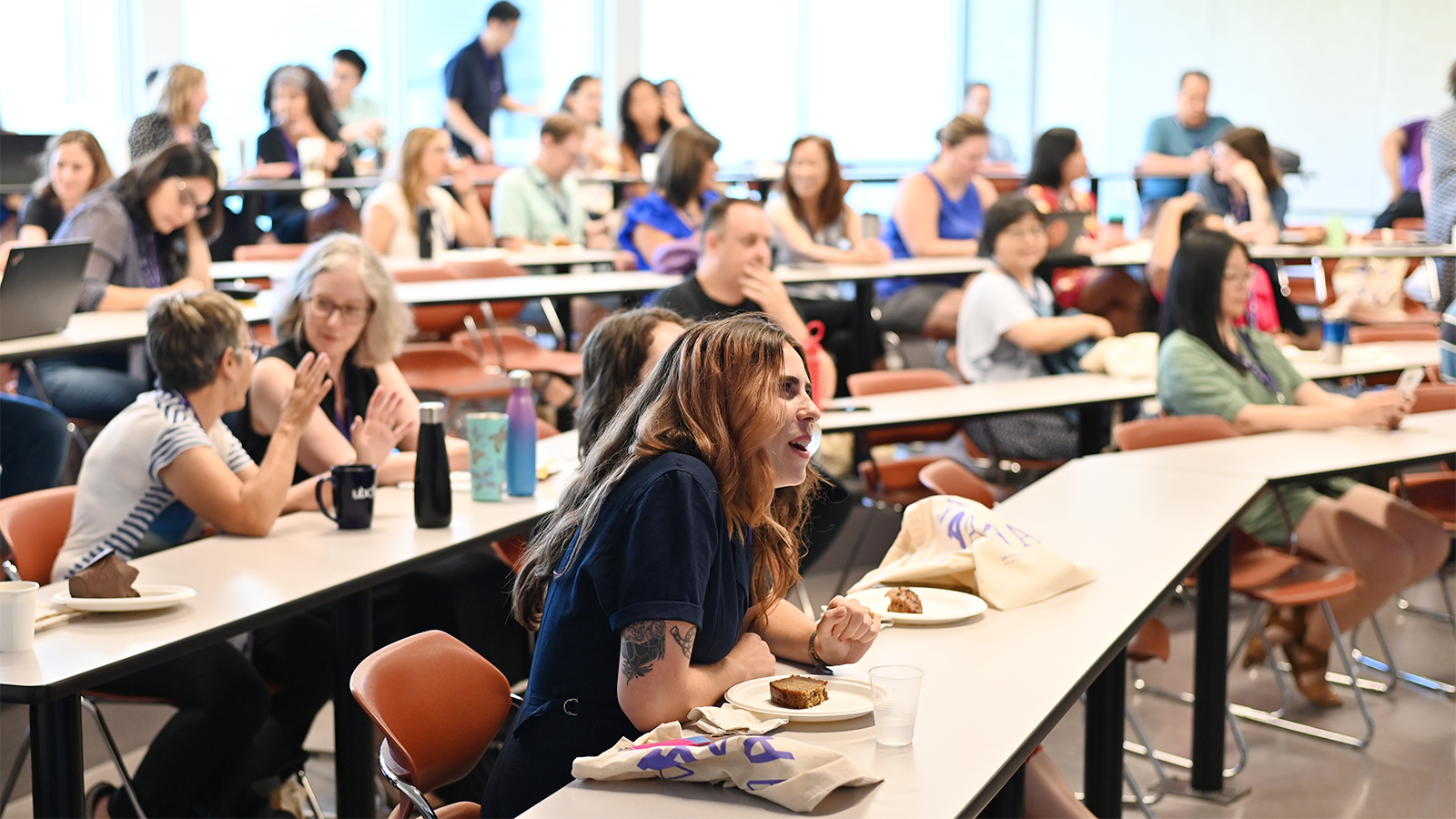Students are used to encountering specific types of assignments that build on specific skill sets in their different disciplines: English students expect to write literary arguments, History students expect to perform secondary research, and so on. Introducing a new or unexpected type of assignment, like an ePortfolio, can cause anxiety or resistance in some students.
The following strategies can mitigate student unease about this course requirement:
"Students have to know what an e-portfolio is, how to use one and, most importantly, how it may benefit them in order for the project to succeed. Without this, students will not view the approach as being meaningful and will not understand that e-portfolios can work to engage them more deeply in learning." – David Tosh, Canadian Journal of Learning and Technology
At its best, the ePortfolio is a student-centred initiative. A student must take ownership of their ePortfolio for it to have significance and longevity.
Strategies for soliciting student buy-in:
- Note that the ePortfolio is both a product – a place to share work that speaks to a broad audience – and a process – a way to practice articulating how academic coursework fits with the ‘big picture’ of one’s cumulative experiences.
- Emphasize the importance of owning and curating one’s digital identity.4
- Make connections with work done in other contexts (e.g. co-op work terms, student clubs, activities, volunteer roles, etc.)
- Show student videos of UBC Arts ePortfolio champions in-class
- Show strong example ePortfolios and describe the context in which they would be used:
- to distinguish between equally competitive job applicants at the interview stage
- to share with prospective contacts for an informational interview
- to impress a prospective Masters or PhD supervisor
- to be able to see one’s own changes in thinking over time
- to make connections between different academic courses and disciplines
- to share with peers and colleagues for social learning and networking
Encouraging personalization—and both integrating incentives for and developing technical skills to enable students’ creative self-expression—facilitates the ePortfolio’s ability to cultivate integrated thinking and deeper learning. As a student-centered platform, your students’ ePortfolios may not be centered around your specific course or discipline. When students are empowered to own their ePortfolios and to make intentional choices about how they represent their experiences, they are able to engage with the story of their learning authentically.
In their ePortfolios, students can build representations of their own learning in their own voice. As one example of what this personal voice looks like in the classroom, see Daniel Justice’s sample assignment for his first-year First Nations and Indigenous Studies course, in which he describes the ePortfolio as a piece of digital storytelling—that is, a narrative that students must carefully craft, revise, and edit.
Limit the use of required sections or components so that students can personalize the look, organizational scheme, and content of their ePortfolio. Encourage students to include samples of their work from other courses, from their co-curricular activities (co-op placements, internships, involvement with the CCEL or Go Global, and from their non-academic life (sport, volunteer work, language learning, employment, entrepreneurship, artistic and cultural activities, and so on).
To simplify your grading, consider requiring that students tag graded content in posts with a standardized, searchable course tag rather than setting standardized headings or pages for the students.
Strategies for encouraging student creativity:
- Allocate a small number of bonus points for highly personalized websites
- Show examples of great ePortfolios, either from the Arts ePortfolio student website, or from previous students in your own course
- Encourage students to participate in the UBC Arts ePortfolio of the Year competition
- Get students familiar with the full spectrum of add-ons and plug-ins that UBC Blogs supports
- Require students to add samples or descriptions of their co-curricular work, skills, or hobbies as a part of your scaffolded assignment
"Scaffolding helps students succeed by breaking complicated tasks and content into manageable parts of gradually increasing complexity and offering help in the form of co-curricular workshops, work-in-progress feedback, reference resources and instructional tools." – Centre for Teaching and Learning, University of Toronto Scarborough
Scaffolding your assignment involves building a series of supportive steps towards a final project. Students can integrate the feedback they receive at one step into their work in the next, and can develop their ideas as they progress incrementally.
Scaffolding has the added benefit of deterring plagiarism, as students are required to show their incremental steps as they build towards a final product. If you are planning to re-use your ePortfolio assignment year after year, remember that previous years’ student work will be available online.
Strategies for scaffolding your ePortfolios:
- Use tiers of complexity: have students submit written work in increasingly complex modes of discourse, from brainstorming to analyzing to arguing. See Daniel Justice’s First Nations and Indigenous Studies 100-level ePortfolio assignment as an example.
- Integrate group work and peer feedback on drafts before the submission of a final product. See Christine D’Onofrio’s Visual Arts 100-level ePortfolio assignment as an example.
- Refer to assignment sequencing or scaffolding resources such as:
Students in courses with an ePortfolio component report difficulty understanding the technology when they are left to figure it out on their own. While aspects of WordPress are intuitive and easy-to-learn, students regularly struggle with, for example, using posts and pages, categorizing posts, and posting images.
When students encounter these problems outside of the classroom, they may turn to Google and find it difficult to get answers. Dedicating in-class time to playing with WordPress and the UBC Arts ePortfolio student resources in small groups in early or mid-semester helps students to identify the gaps in their knowledge in a supported environment, so they don’t end up struggling alone.
Strategies for exploring WordPress in-class:
- Reward small-group play: Adapt the 25-minute scavenger hunt activity to your course. [Example]
- Flip the classroom: Collect a set of student resource videos or readings, design a short activity to test student understanding, and have students complete the activity in-class.
- Develop small-stakes mid-semester crits: At the beginning of the semester, have the students draw on paper what they may want some of the pages on their ePortfolio to look like. In mid-semester, meet with them in small groups to discuss the differences between the site they planned and the site they’ve made. Have the students prepare small, graded presentations that articulate how their thinking about the ePortfolio has changed and where they are struggling with the tech.
The ePortfolio is a tool for integrated learning, synthesis, connection, and reflection, and so it is particularly well-suited to assignments that share one or more of these traits.
Consider engaging students with authentic, real-world problems in which they can apply their learning from your class. Have your students solve an actual problem, engage with a local or global issue, or address an audience other than their professor.
Strategies for ensuring a logical fit:
- Translate knowledge: consider how your former students apply the knowledge they gained during their undergraduate degrees, and ask your current students to practice similarly applying their learning.
- Get local: draw on contemporary on- or off-campus concerns. Have students apply what they have learned in the class to their local context. See Michael Griffin’s second-year Philosophy assignment as an example.
- See problem-based learning resources:
Your students will be dedicating a substantial quantity of their time developing sites that they are proud of. Many will want their efforts to be reflected in the value assigned to their work.
For many courses, students will use their ePortfolio to post one or more assignments or components or an assignment. For example, see this FNIS100 sample assignment, in which the ePortfolio housed a series of scaffolded assignments, together totaling 40% of the total assessment for the course.
In contrast, in this VISA110 sample assignment, students first analyzed the ePortfolio as a form and genre, and then built their own; between interrogating, presenting, building, and critiquing ePortfolios, this project totaled XX% of their final grade for the course.
We recommend dedicating at least 30% or 40% of your grades for the course to the ePortfolio and/or its constituent assignments. Because of the quantity of time required to create the sites, we advise against dedicating 10% or less to the ePortfolio project(s). When students see a small grade attached to the ePortfolio, they tend to view it as a surplus, unimportant assignment, and can resent the quantity of time it takes to complete.
To reach the 30-40% recommended minimum, consider bringing two or more closely linked, increasingly difficult assignments into the ePortfolio. See “Scaffold your assignment”.
"[S]ocial pedagogy dramatically enhances the value of the reflective portfolio. Actual engagement with meaningful audiences through the ePortfolio correlates strongly with deeper and more integrative forms of student learning." – Catalyst for Learning, Social Pedagogies in ePortfolio Practices: Principles for Design and Impact
ePortfolios are designed to address a broad audience, from professors and TA to family members, potential employers, and members of the community. Both student surveys and classroom testing have shown that the combination of ePortfolios with peer feedback enhances students’ ability to construct and communicate understanding.
Strategies for integrating peer and instructor feedback:
- Include a ‘crit’ or presentation in which students share their ePortfolios in large or small groups before submission.
- Have students complete a peer feedback worksheet or rubric to articulate the areas of strength and provide constructive criticism
- Have students record a 3-5 minute audio file in which the narrate the experience of navigating and reviewing another students’ ePortfolio
- Use tools like Compair or PeerScholar to have students review and give feedback online
- Provide instruction/training for students to teach them how to give constructive feedback
- Select a few examples of student work to conduct a guided in-class review (or do a video review of work from a previous term)
- Create a hub site or use a discussion forum to aggregate and share student portfolio assignments for the course
"The function of reflection is to make meaning, to formulate relationships and continuities among the elements of an experience, between that experience and other experiences, between that knowledge and the knowledge produced by thinkers other than oneself. …The creation of meaning out of experience is at the very heart of what it means to be human. It is what enables us to make sense of attribute value to the events of our lives." – Carol Rogers, Teachers’ College Record
In their ePortfolios, students create a record of their accomplishments and present their records in a new context. Actively reviewing their activities helps students to see the big picture of their learning, and more deeply internalize core concepts.
The process of comparing current work to previous work makes visible to students changes in their thinking. They can chart the trajectory of their learning over a semester, year, or degree program, as they reflect on both how and what they learned.
Strategies for facilitating reflection:
- Sum it up: have students write contextual blurbs for their work samples, explaining their process and results.
- Clarify what reflection entails: require that students write accomplishment statements or analyses of their learning process. [Example – Camille Porter, Geography]
- Blog: have students create a narrative of their learning over the course of a semester, as project components build. [Example – Christa Yeung, Geography]


